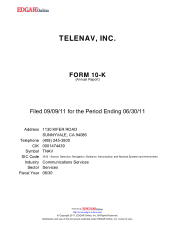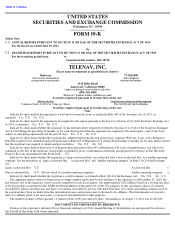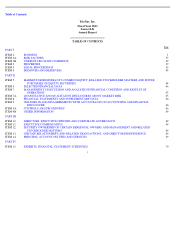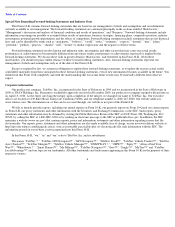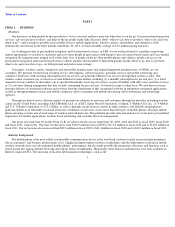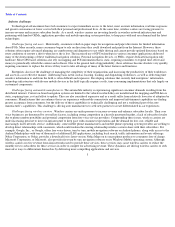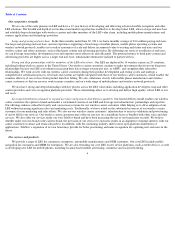TeleNav 2011 Annual Report Download - page 10
Download and view the complete annual report
Please find page 10 of the 2011 TeleNav annual report below. You can navigate through the pages in the report by either clicking on the pages listed below, or by using the keyword search tool below to find specific information within the annual report.
Table of Contents
transmit information wirelessly to the enterprise’s back-end systems via our customizable workflow and flexible forms from their mobile
phones. Key features and functions of our MRM solutions include:
Automotive on-board and connected navigation . We have been working with certain automobile manufacturers and OEM customers to
provide our mobile navigation services through on-board and connected systems. Our technology powers automotive navigation services that
provide accurate, easy to use and connected LBS to drivers at a low cost. Our first automotive navigation service became available as a premium
option in the 2010 Ford Focus and Taurus models sold in North America, and it continues to expand to other Ford and Lincoln vehicles today.
By combining Microsoft’s SYNC and other connected technologies with our GPS technologies in these vehicles, drivers are able to utilize their
car’s existing radio screen and speaker system in conjunction with their mobile phone to utilize our LBS. In addition, Ford has utilized our on-
board automotive navigation product in the next generation Ford SYNC platform, which includes MyFord Touch and MyLincoln Touch. Ford
began shipping this product in certain North American vehicles with the 2011 model year, with planned availability in selected international
markets thereafter.
Location based mobile advertising . In fiscal 2010, we launched mobile location based advertising services that deliver location based and
time sensitive mobile advertising with features such as location specific sponsored listings, content, coupons and dining menus. We currently
provide mobile search based advertising for our key wireless carrier customers, including AT&T, Sprint, T-Mobile and U.S. Cellular. We have
access to over 800,000 advertisers through a network of providers and we have created unique ad units for the mobile space, including the “
drive
to” advertising unit. This is an ad unit for which advertisers pay when users, in response to an advertisement, click a “drive to” button that
provides the user a GPS navigation session that takes them directly to the advertised location.
End user billing and support
End user billing . End users are generally billed for our services through their wireless carrier, which may offer our services on a
standalone basis or bundled with other voice and data services. The wireless carriers bill subscribers monthly. We and our wireless carrier
customers may offer subscribers a 30-day free trial for our service. We believe that the wireless carrier billing makes our services more
appealing to consumers and enterprises as they are not required to pay a separate monthly charge to a different vendor. For a small minority of
end users who purchase our LBS through our website or in application stores, we bill their credit cards directly on a monthly basis, or utilize the
application store billing process.
End user support . Our wireless carrier customers generally provide first level support to their subscribers if the wireless carrier provides
our services on a white label basis. We provide secondary support for issues that cannot be resolved by our wireless carrier customers. If the
service is provided under the TeleNav brand, we
6
•
voice guided, turn by turn directions to efficiently navigate workers to their destinations;
•
real time and historical reports of the location of the mobile workforce and routes taken and transit times as compared to optimal
routes and ideal transit times;
•
updated job status information to improve efficiency and productivity in connection with assignments;
•
automatic alerts when workers or vehicles enter or exit a specific area, have stopped or are speeding;
•
customizable wireless forms to capture field information and improve communication, including job details, signatures and barcode
scans;
•
wireless timecards to improve payroll accuracy and workforce time and attendance; and
•
integration with an enterprise’s back-end systems and applications, such as accounting, billing and dispatching applications that
together support business process mobilization through the movement of real time information.

